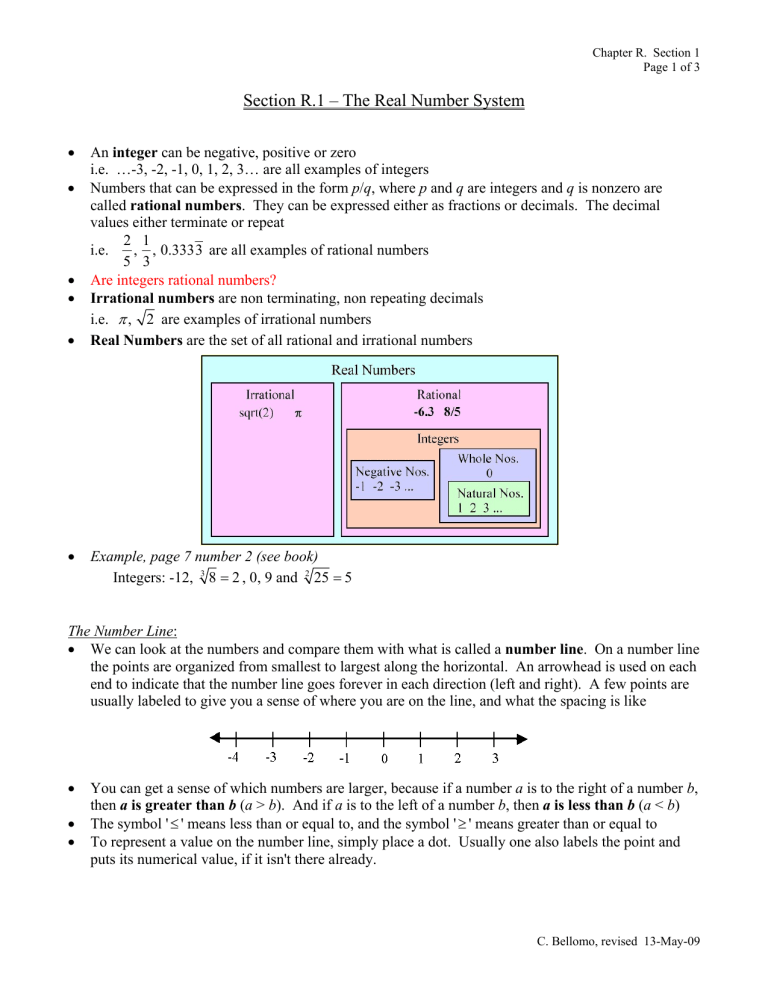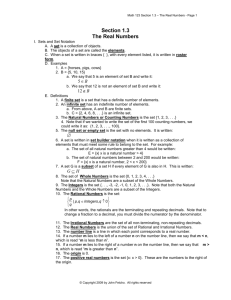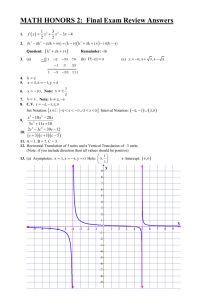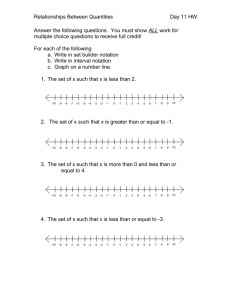Real No. System

Chapter R. Section 1
Page 1 of 3
Section R.1 – The Real Number System
•
An integer can be negative, positive or zero i.e. …-3, -2, -1, 0, 1, 2, 3… are all examples of integers
•
Numbers that can be expressed in the form p / q , where p and q are integers and q is nonzero are called rational numbers . They can be expressed either as fractions or decimals. The decimal values either terminate or repeat i.e.
2 1
, , 0.3333
are all examples of rational numbers
5 3
•
Are integers rational numbers?
•
Irrational numbers are non terminating, non repeating decimals i.e.
π
, 2 are examples of irrational numbers
•
Real Numbers are the set of all rational and irrational numbers
•
Example, page 7 number 2 (see book)
Integers: -12, 3 8
=
2 , 0, 9 and 2 25
=
5
The Number Line :
•
We can look at the numbers and compare them with what is called a number line . On a number line the points are organized from smallest to largest along the horizontal. An arrowhead is used on each end to indicate that the number line goes forever in each direction (left and right). A few points are usually labeled to give you a sense of where you are on the line, and what the spacing is like
•
You can get a sense of which numbers are larger, because if a number a is to the right of a number b , then a is greater than b ( a > b ). And if a is to the left of a number b , then a is less than b ( a < b )
•
The symbol '
≤
' means less than or equal to, and the symbol '
≥
' means greater than or equal to
•
To represent a value on the number line, simply place a dot. Usually one also labels the point and puts its numerical value, if it isn't there already.
C. Bellomo, revised 13-May-09
Chapter R. Section 1
Page 2 of 3
•
Example, label the point
−
4 on the number line below
3
Intervals :
•
An interval can be thought of as a range of values on a number line. It could be a line segment (from a to b ), or a ray (from b to infinity)
•
These intervals can be expressed in many ways, the first being interval notation , which uses the endpoints. The expression ( a , b ) indicates all the real numbers between a and b (but not including a and b themselves)
•
Formally ( , )
=
{ |
< < b }
NOTE: The above left is interval notation, and the above right is set builder notation. It reads 'the set of all x such that a is less than x is less than b '. I will not stress set builder notation much
•
Interval notation uses a combination of the symbols ( [ ) and ]
The parenthesis '(' indicate the endpoint is not included (open), and the brackets '[' indicate the endpoint is included (closed)
•
If an interval goes on and on in one direction, we can use interval notation with the infinity symbol.
For example, if x
≥
10 , we say x goes from 10 to infinity, or [10, )
•
NOTE: always use the open bracket '(' with this symbol
We can also do this in the other direction, say x < 6. The interval is written as (
−∞
, 6)
•
There is another way to represent an interval besides set builder notation and interval notation, and that is graphically on the number line.
For the endpoints you can either uses [,(,],) or dots (filled in would be closed, hollow would be open)
•
Example, express the interval (-2,1] on the number line
•
Example. Write { | 3 x } in interval notation and graph
(
−∞
, 3)
•
Example, page 7 number 26. (see book)
( x , x + h ]
C. Bellomo, revised 13-May-09
Chapter R. Section 1
Page 3 of 3
Set Notation :
•
Informally, a set is defined as a group of things called elements
•
We usually use capitol letters for sets, and lower case letters for elements
•
It must be clear what is included and not included, or the set is not 'well defined'
For example is 'all positive numbers' a well defined set? How about 'all great men'?
•
The following symbols are used when describing sets: a
∈
A a
∉
A
: The element a is in the set A
A B
: The element a is not in the set A
⊆
: The set A is inside (or equal to) the set B , meaning all the elements in A are in B
•
Example. True or false 0
∉ Ν
True, N is the set of natural numbers, and 0 is not included
•
Example. True or false
Ν ⊆
W
True, the set of natural numbers are contained in the set of whole numbers
(whole numbers include the natural numbers and 0)
Absolute Value :
•
The definition of the absolute value function is given as
≥
0 x
⎩ − x x x x
≤
0
It is often taught in school as "strip away the minus if it's positive," but this is actually incorrect. If the value of x is negative, you multiply x by a negative 1.
•
Trouble occurs when you move away from numbers into symbols. In other words, what is the absolute value of a ?
•
We will visit this later, and for now focus on the absolute value of numerical values only
•
Example. Simplify
−
3
( 3)
=
3
•
To find the distance between two points a and b on the number line , find a b
•
Example. Find the distance between
15 23
,
8 12
15
−
23
=
1
8 12 24
C. Bellomo, revised 13-May-09






